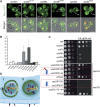ESCRT-II coordinates the assembly of ESCRT-III filaments for cargo sorting and multivesicular body vesicle formation
- PMID: 20134403
- PMCID: PMC2837172
- DOI: 10.1038/emboj.2009.408
ESCRT-II coordinates the assembly of ESCRT-III filaments for cargo sorting and multivesicular body vesicle formation
Abstract
The sequential action of five distinct endosomal-sorting complex required for transport (ESCRT) complexes is required for the lysosomal downregulation of cell surface receptors through the multivesicular body (MVB) pathway. On endosomes, the assembly of ESCRT-III is a highly ordered process. We show that the length of ESCRT-III (Snf7) oligomers controls the size of MVB vesicles and addresses how ESCRT-II regulates ESCRT-III assembly. The first step of ESCRT-III assembly is mediated by Vps20, which nucleates Snf7/Vps32 oligomerization, and serves as the link to ESCRT-II. The ESCRT-II subunit Vps25 induces an essential conformational switch that converts inactive monomeric Vps20 into the active nucleator for Snf7 oligomerization. Each ESCRT-II complex contains two Vps25 molecules (arms) that generate a characteristic Y-shaped structure. Mutant 'one-armed' ESCRT-II complexes with a single Vps25 arm are sufficient to nucleate Snf7 oligomerization. However, these oligomers cannot execute ESCRT-III function. Both Vps25 arms provide essential geometry for the assembly of a functional ESCRT-III complex. We propose that ESCRT-II serves as a scaffold that nucleates the assembly of two Snf7 oligomers, which together are required for cargo sequestration and vesicle formation during MVB sorting.
Conflict of interest statement
The authors declare that they have no conflict of interest.
Figures






Similar articles
-
Ordered assembly of the ESCRT-III complex on endosomes is required to sequester cargo during MVB formation.Dev Cell. 2008 Oct;15(4):578-89. doi: 10.1016/j.devcel.2008.08.013. Dev Cell. 2008. PMID: 18854142
-
The endosomal sorting complex ESCRT-II mediates the assembly and architecture of ESCRT-III helices.Cell. 2012 Oct 12;151(2):356-71. doi: 10.1016/j.cell.2012.08.039. Cell. 2012. PMID: 23063125
-
Coordinated binding of Vps4 to ESCRT-III drives membrane neck constriction during MVB vesicle formation.J Cell Biol. 2014 Apr 14;205(1):33-49. doi: 10.1083/jcb.201310114. Epub 2014 Apr 7. J Cell Biol. 2014. PMID: 24711499 Free PMC article.
-
ESCRT-III on endosomes: new functions, new activation pathway.Biochem J. 2016 Jan 15;473(2):e5-8. doi: 10.1042/BJ20151115. Biochem J. 2016. PMID: 26733719 Review.
-
ESCRT-dependent cargo sorting at multivesicular endosomes.Semin Cell Dev Biol. 2018 Feb;74:4-10. doi: 10.1016/j.semcdb.2017.08.020. Epub 2017 Aug 8. Semin Cell Dev Biol. 2018. PMID: 28797838 Free PMC article. Review.
Cited by
-
Nuclear and degradative functions of the ESCRT-III pathway: implications for neurodegenerative disease.Nucleus. 2024 Dec;15(1):2349085. doi: 10.1080/19491034.2024.2349085. Epub 2024 May 3. Nucleus. 2024. PMID: 38700207 Free PMC article. Review.
-
Endosomal Arl4A attenuates EGFR degradation by binding to the ESCRT-II component VPS36.Nat Commun. 2023 Nov 29;14(1):7859. doi: 10.1038/s41467-023-42979-9. Nat Commun. 2023. PMID: 38030597 Free PMC article.
-
Insights into the function of ESCRT and its role in enveloped virus infection.Front Microbiol. 2023 Oct 6;14:1261651. doi: 10.3389/fmicb.2023.1261651. eCollection 2023. Front Microbiol. 2023. PMID: 37869652 Free PMC article. Review.
-
Vps60 initiates alternative ESCRT-III filaments.J Cell Biol. 2023 Nov 6;222(11):e202206028. doi: 10.1083/jcb.202206028. Epub 2023 Sep 28. J Cell Biol. 2023. PMID: 37768378 Free PMC article.
-
Accessory ESCRT-III proteins are conserved and selective regulators of Rab11a-exosome formation.J Extracell Vesicles. 2023 Mar;12(3):e12311. doi: 10.1002/jev2.12311. J Extracell Vesicles. 2023. PMID: 36872252 Free PMC article.
References
-
- Alam SL, Langelier C, Whitby FG, Koirala S, Robinson H, Hill CP, Sundquist WI (2006) Structural basis for ubiquitin recognition by the human ESCRT-II EAP45 GLUE domain. Nat Struct Mol Biol 13: 1029–1030 - PubMed
-
- Babst M, Katzmann DJ, Estepa-Sabal EJ, Meerloo T, Emr SD (2002a) Escrt-III: an endosome-associated heterooligomeric protein complex required for mvb sorting. Dev Cell 3: 271–282 - PubMed
-
- Babst M, Katzmann DJ, Snyder WB, Wendland B, Emr SD (2002b) Endosome-associated complex, ESCRT-II, recruits transport machinery for protein sorting at the multivesicular body. Dev Cell 3: 283–289 - PubMed
-
- Babst M, Odorizzi G, Estepa EJ, Emr SD (2000) Mammalian tumor susceptibility gene 101 (TSG101) and the yeast homologue, Vps23p, both function in late endosomal trafficking. Traffic 1: 248–258 - PubMed
Publication types
MeSH terms
Substances
Grants and funding
LinkOut - more resources
Full Text Sources
Other Literature Sources
Molecular Biology Databases


